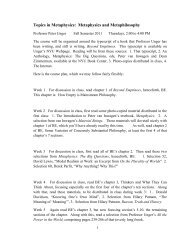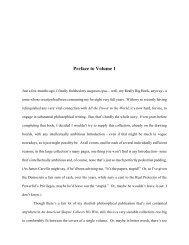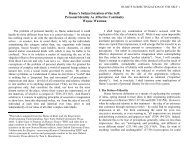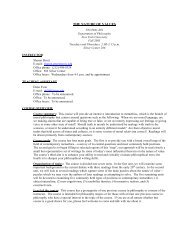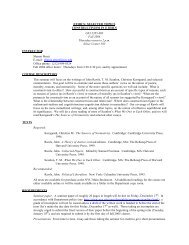1 Rough Equality, Rougher Inequalities, and the 'Jostlings of ...
1 Rough Equality, Rougher Inequalities, and the 'Jostlings of ...
1 Rough Equality, Rougher Inequalities, and the 'Jostlings of ...
You also want an ePaper? Increase the reach of your titles
YUMPU automatically turns print PDFs into web optimized ePapers that Google loves.
to counteract over time men's <strong>and</strong> women's adaptation to pernicious gender norms inlove, family, <strong>and</strong> society at large. Such deep, egalitarian reforms in education wouldgradually trigger a paradigm shift in <strong>the</strong> way that men <strong>and</strong> women saw <strong>and</strong> treated eacho<strong>the</strong>r. As lifelong friends who had roughhoused on <strong>the</strong> playground according to <strong>the</strong> samerules, adult men <strong>and</strong> women would be psychologically primed to put into practice <strong>the</strong>moral principle <strong>of</strong> equal respect. Given <strong>the</strong> political advances in <strong>the</strong> legal recognition <strong>of</strong><strong>the</strong> natural rights <strong>of</strong> humans during <strong>the</strong> American <strong>and</strong> French revolutions, Wollstonecraftharbored a reasonable hope that equally educated adults could learn to work in t<strong>and</strong>em toinstitutionalize human rights in law <strong>and</strong> culture. Taking <strong>the</strong> long view, she posited equalpublic education as <strong>the</strong> means by which <strong>the</strong> principle <strong>of</strong> equal respect would become <strong>the</strong>basis for institutionalizing <strong>the</strong> rough equality <strong>of</strong> humans, <strong>the</strong>reby remedying, over time,<strong>the</strong>ir rougher <strong>and</strong> arbitrary experiences <strong>of</strong> inequality.So, yes, I agree with Tomaselli that Wollstonecraft began <strong>the</strong> non-ideal dimension<strong>of</strong> her political <strong>the</strong>ory with <strong>the</strong> fact <strong>of</strong> human inequality. To paraphrase her interlocutorRousseau, she began with women as <strong>the</strong>y are, to <strong>the</strong>orize what <strong>the</strong>y might become. But itwas in <strong>the</strong> practical yet principled spirit <strong>of</strong> Hobbes that she did so. Humans were notequal in practice, nor would <strong>the</strong>y ever fully be so. But <strong>the</strong>y were equal enough: all thingsconsidered, <strong>the</strong>y were roughly equal. A smart woman could outwit a dumb man, <strong>and</strong> astrong man could dominate a weak woman, any day...or night. It all evened out, whenyou looked at human capabilities from a comparative perspective.Yet, like John Stuart Mill after her, Wollstonecraft allowed <strong>the</strong> possibility thatgirls <strong>and</strong> women might, over time, through greater opportunities in physical education<strong>and</strong> health care, develop <strong>the</strong>mselves to achieve <strong>the</strong> same or greater physical strength as2



